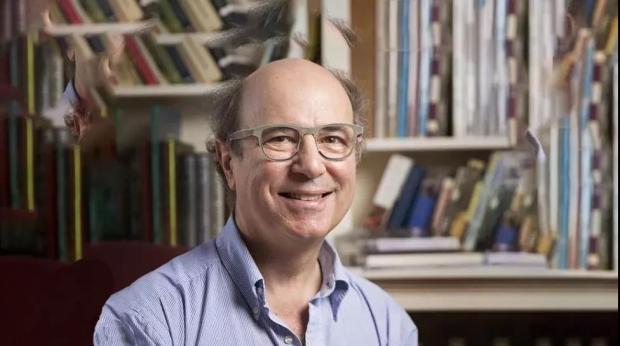阅读:0
听报道
撰文 | Frank Wilczek
翻译 | 胡风、梁丁当
编辑 | 王茹茹
中文版
当科学家像婴儿一样,带着好奇心重新感受这个世界时,他们或许会产生全新的认识。
这阵子,我眼瞅着外孙卢克 (Luke) 从一个嗷嗷待哺的婴儿长成了蹒跚学步的小孩。看着他开始学习理解这个世界,让我感触颇深。我瞧着他坐在高脚椅上,一次次地把勺子扔下,看着勺子落到地上。相信每位父母(或者祖父母)都见过这种严肃又好笑的“实验”。
通过这些实验,孩子们学会了如何把透过我们的微小瞳孔,打到二维视网膜上的光子簇翻译成我们生活的三维世界。而通过另一些孩子气的思考,他们逐渐建立起关于自我的意识和理解他人思想的模式。这是一项伟大的成就。人工智能的研究者们一直努力地尝试复制这些过程,却收获有限。
对日常世界的观察是孩子认识这个世界的有效且合理的方式。但是我们的眼睛看不到遥远的星系,也看不到构成物质的原子与分子。无论是驱动收音机和微波炉的电磁波,还是为我们的肌肉提供力量、编码我们思维意识的电流,都是看不见摸不着的。我们没有蛇的红外线感受器,也不像蜜蜂那样能看到紫外线,或是像蝙蝠那样有接收超声波的能力。
现代科学所揭示的物理世界与我们在孩童时期构建的模型有着根本的不同。科学仪器可以帮助我们感知五感之外的世界。我们可以使用显微镜、望远镜、磁力计、粒子加速器、原子钟和其他工具来探索这个真实的物理世界。
更重要的是,我们能够通过批判性的推理直达世界的本质,再借助想象力将其重新构建。在人类的时间尺度上,宇宙是巨大而古老的。但如果这个世界本身是浩瀚丰富的,那我们亦是如此。正如沃尔特·惠特曼 (Walt Whitman) 所欢呼的 :“我是包罗万象的。”在每个人的大脑中,复杂的神经元星罗棋布。它们在我们的一生中会释放数十亿次的电信号,形成了信息与思维的动态模式。
如果你重新向这个世界敞开心扉,好奇地、不先入为主地去感受它——就好像你重生了一样——你将会发现打开隐藏之门的新钥匙。这里的“重生”与福音所启示的生命“重生”完全不同。它契合的是《圣经》中圣保罗 (Saint Paul) 所描述的:“当我是个孩子的时候,我说话像孩子,心思像孩子,想法像孩子;但当我长大以后,便丢掉了一切的孩子气。”
科学的理解并不能取代我们的日常思维方式,但可以扩展并强化我们的思维。当我们能够更加全面地认识这个世界时,在真理的光芒映衬下,彩虹更加绚丽,星空更加璀璨,人的思想也更加迷人。或许在某个时刻,你就到达了威廉 · 布莱克 (William Blake) 所描绘的境界:
一沙一世界
一叶一天堂
掌中有无限
须臾亦永恒
英文版
ILLUSTRATION: TOMASZ WALENTA
Like infants exploring how the world works, scientists are driven by curiosity and awe to build a deeper picture of reality.
Recently I’ve been watching my grandson develop from a helpless infant into a functioning child. It’s inspiring and deep to see Luke learn to make sense of the world. I watched him drop spoons from his high chair over and over again, each time checking that they’d relocated to the ground. Every parent (or grandparent) has seen such comical yet deeply serious “experiments.”
Through these investigations, babies learn how to translate the jumble of photons that pass through our tiny pupils and impinge on our two-dimensional retinas into the three-dimensional world of objects that we navigate in everyday life. Other babyish meditations build up our concept of self and our explanatory models of other minds inside other bodies. These are great achievements. Researchers in artificial intelligence have struggled to replicate them, with limited success.
To understand reality, it’s efficient and reasonable for children to take lessons from the way things behave in the everyday world. But our eyes can’t perceive distant galaxies or the atoms and molecules that build up matter. The electromagnetic waves that power radios and microwave ovens pass unnoticed, as do the electric flows that power our muscles and encode our thoughts. We do not have the infrared vision of snakes, the ultraviolet vision of bees, or bats’ ability to pick up ultrasound.
The physical world revealed by modern science is fundamentally different from the model we construct as babies. Scientific instruments let us perceive the world better than we can using only our bodies. We can use microscopes, telescopes, spectroscopes, magnetometers, particle accelerators, atomic clocks and other tools to explore the physical world’s reality.
Even more crucially, we can use critical reasoning to bore down to fundamentals and imagination to build them back up again. The universe is vastly large and vastly old, on human time scales. But if the world is abundant, so are we. As Walt Whitman exulted, “I contain multitudes.” Every human brain contains a galaxy’s worth of complex neurons that fire billions of times within our lifetime, creating dynamic patterns of information and thought.
If you once again open yourself up to the world, curious and without preconceptions—if you allow yourself to be born again—you will find new keys that open hidden doors. This is, of course, quite different from being “born again” in the sense of evangelical revelation. Yet it beautifully fulfills Saint Paul’s verse: “When I was a child, I spoke as a child, I understood as a child, I thought as a child; but when I became a man, I put away childish things.”
Scientific understanding does not replace the modes of thought we use in everyday life, but it can supplement and enhance them. Rainbows are more beautiful, the starry night is more awesome, and other minds are more fascinating when you view them more fully, by the light of fundamental realities they reflect. You may come, in special moments, to live out William Blake’s vision:
To see a World in a Grain of Sand
And a Heaven in a Wild Flower
Hold Infinity in the palm of your hand
And Eternity in an hour.

Frank Wilczek
弗兰克·维尔切克是麻省理工学院物理学教授、量子色动力学的奠基人之一。因发现了量子色动力学的渐近自由现象,他在2004年获得了诺贝尔物理学奖。
本文经授权转载自微信公众号“蔻享学术”。
话题:
0
推荐
财新博客版权声明:财新博客所发布文章及图片之版权属博主本人及/或相关权利人所有,未经博主及/或相关权利人单独授权,任何网站、平面媒体不得予以转载。财新网对相关媒体的网站信息内容转载授权并不包括财新博客的文章及图片。博客文章均为作者个人观点,不代表财新网的立场和观点。




 京公网安备 11010502034662号
京公网安备 11010502034662号 